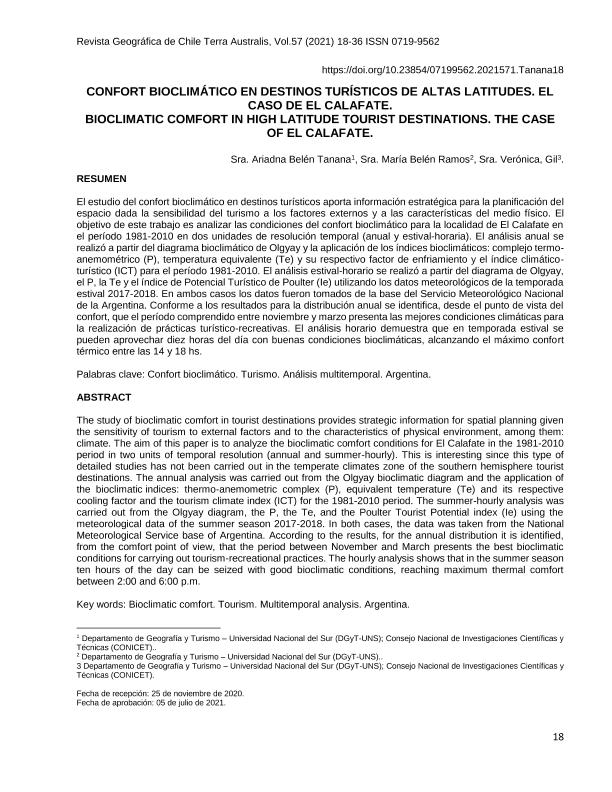Mostrar el registro sencillo del ítem
dc.contributor.author
Tanana, Ariadna Belén

dc.contributor.author
Ramos, María Belén

dc.contributor.author
Gil, Veronica

dc.contributor.author
Campo, Alicia María

dc.date.available
2022-06-16T13:46:34Z
dc.date.issued
2021-12-31
dc.identifier.citation
Tanana, Ariadna Belén; Ramos, María Belén; Gil, Veronica; Campo, Alicia María; Confort bioclimático en destinos turísticos de altas latitudes: el caso de El Calafate; Instituto Geográfico Militar. Observatorio en Gestión de Riesgo de Desastres; Revista Geográfica de Chile Terra Australis; 57; 1; 31-12-2021; 18-36
dc.identifier.issn
0378-8482
dc.identifier.uri
http://hdl.handle.net/11336/159928
dc.description.abstract
El estudio del confort bioclimático en destinos turísticos aporta información estratégica para la planificación del espacio dada la sensibilidad del turismo a los factores externos y a las características del medio físico. El objetivo de este trabajo es analizar las condiciones del confort bioclimático para la localidad de El Calafate en el período 1981-2010 en dos unidades de resolución temporal (anual y estival-horaria). El análisis anual se realizó a partir del diagrama bioclimático de Olgyay y la aplicación de los índices bioclimáticos: complejo termo-anemométrico (P), temperatura equivalente (Te) y su respectivo factor de enfriamiento y el índice climático-turístico (ICT) para el período 1981-2010. El análisis estival-horario se realizó a partir del diagrama de Olgyay, el P, la Te y el índice de Potencial Turístico de Poulter (Ie) utilizando los datos meteorológicos de la temporada estival 2017-2018. En ambos casos los datos fueron tomados de la base del Servicio Meteorológico Nacional de la Argentina. Conforme a los resultados para la distribución anual se identifica, desde el punto de vista del confort, que el período comprendido entre noviembre y marzo presenta las mejores condiciones climáticas para la realización de prácticas turístico-recreativas. El análisis horario demuestra que en temporada estival se pueden aprovechar diez horas del día con buenas condiciones bioclimáticas, alcanzando el máximo confort térmico entre las 14 y 18 hs.
dc.description.abstract
The study of bioclimatic comfort in tourist destinations provides strategic information for spatial planning given the sensitivity of tourism to external factors and to the characteristics of physical environment, among them: climate. The aim of this paper is to analyze the bioclimatic comfort conditions for El Calafate in the 1981-2010 period in two units of temporal resolution (annual and summer-hourly). This is interesting since this type of detailed studies has not been carried out in the temperate climates zone of the southern hemisphere tourist destinations. The annual analysis was carried out from the Olgyay bioclimatic diagram and the application of the bioclimatic indices: thermo-anemometric complex (P), equivalent temperature (Te) and its respective cooling factor and the tourism climate index (ICT) for the 1981-2010 period. The summer-hourly analysis was carried out from the Olgyay diagram, the P, the Te, and the Poulter Tourist Potential index (Ie) using the meteorological data of the summer season 2017-2018. In both cases, the data was taken from the National Meteorological Service base of Argentina. According to the results, for the annual distribution it is identified, from the comfort point of view, that the period between November and March presents the best bioclimatic conditions for carrying out tourism-recreational practices. The hourly analysis shows that in the summer season ten hours of the day can be seized with good bioclimatic conditions, reaching maximum thermal comfort between 2:00 and 6:00 p.m.
dc.format
application/pdf
dc.language.iso
spa
dc.publisher
Instituto Geográfico Militar. Observatorio en Gestión de Riesgo de Desastres
dc.rights
info:eu-repo/semantics/openAccess
dc.rights.uri
https://creativecommons.org/licenses/by-nc-sa/2.5/ar/
dc.subject
CONFORT BIOCLIMÁTICO
dc.subject
TURISMO
dc.subject
ANÁLISIS MULTITEMPORAL
dc.subject
ARGENTINA
dc.subject.classification
Otras Ciencias Sociales

dc.subject.classification
Otras Ciencias Sociales

dc.subject.classification
CIENCIAS SOCIALES

dc.title
Confort bioclimático en destinos turísticos de altas latitudes: el caso de El Calafate
dc.title
Bioclimatic comfort in high latitude tourist destinations: the case of Calafate
dc.type
info:eu-repo/semantics/article
dc.type
info:ar-repo/semantics/artículo
dc.type
info:eu-repo/semantics/publishedVersion
dc.date.updated
2022-05-17T12:51:07Z
dc.identifier.eissn
0719-9562
dc.journal.volume
57
dc.journal.number
1
dc.journal.pagination
18-36
dc.journal.pais
Chile

dc.description.fil
Fil: Tanana, Ariadna Belén. Consejo Nacional de Investigaciones Científicas y Técnicas. Centro Científico Tecnológico Conicet - Bahía Blanca; Argentina. Universidad Nacional del Sur. Departamento de Geografía y Turismo; Argentina
dc.description.fil
Fil: Ramos, María Belén. Universidad Nacional del Sur. Departamento de Geografía y Turismo; Argentina
dc.description.fil
Fil: Gil, Veronica. Consejo Nacional de Investigaciones Científicas y Técnicas. Centro Científico Tecnológico Conicet - Bahía Blanca; Argentina. Universidad Nacional del Sur. Departamento de Geografía y Turismo; Argentina
dc.description.fil
Fil: Campo, Alicia María. Consejo Nacional de Investigaciones Científicas y Técnicas. Centro Científico Tecnológico Conicet - Bahía Blanca; Argentina. Universidad Nacional del Sur. Departamento de Geografía y Turismo; Argentina
dc.journal.title
Revista Geográfica de Chile Terra Australis
dc.relation.alternativeid
info:eu-repo/semantics/altIdentifier/url/https://www.revistaterraaustralis.cl/index.php/rgch/article/view/76/39
dc.relation.alternativeid
info:eu-repo/semantics/altIdentifier/doi/http://dx.doi.org/10.23854/07199562.2021571.Tanana18
Archivos asociados
